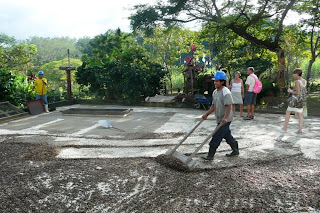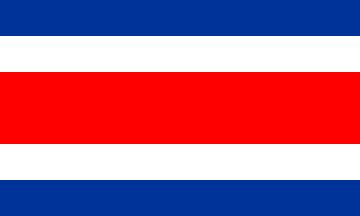The process of growing coffee is very complex. Coffee seeds are planted in small starter boxes with potting soil and compost in October. They are watered every day through March, during the dry season. As the rainy season begins, the treelings are transplanted into the fields two by two, at a density of about 5,000 plants per hectare (2,000 per acre). Once they're in the field, nature provides them with all the water they need. It takes three to four years before the treelings bear fruit. After five years of fruit-bearing, the trees are cut short so they won't grow too high to reach, and the process continues. Typically, a tree lives about 20 years before it's replaced by a new one.
The coffee fruits are picked by hand when they're ripe, either red or just turning red. Inside each fruit are two beans, the coffee beans we're all familiar with but which are still in their raw state with a roughly pistachio color. They're washed and processed overnight to remove the outer skin. The beans are dried either out in the sun or in a special dryer for around 40 hours. Even with the outer skin removed, the beans still have a thin husk on them which is removed and used as fuel for the heat dryers. The processors separate the beans into three grades: highest grade for most drinkers, economy grade for poorer drinkers, and industrial grade for end products like coffee-flavored liqueur and ice cream, as well as specialty lotions. Once the beans are dried they can either be roasted at the plant or shipped raw. Coffee beans are typically shipped raw so they can be roasted at the coffee house for freshest flavor.

Café Diriá uses 100% organic farming methods, although currently it can only sell 10% of its coffee as organic. This is due to the residual chemicals that still exist in some fields, as well as the tendency of some farmers in the coop to still use artificial fertilizers during tough growing seasons. In any case, Café Diriá recycles everything. The bean husks are used as fuel for the dryers as previously mentioned. The waste water from the skinning process is dried out, leaving the coffee skins for use as compost. This compost is distributed to all the farmers in the coop. In lieu of pesticides, they plant chile-pepper trees amongst the coffee trees as a first line of defense. In addition, they take a mixture of lemon juice, chile peppers and garlic and spray it on the trees as a natural insect repellent. It makes a great sauce, too!
After the tour we were served more tasty cups of hot coffee as well as creamy iced coffee and cookies. I bought a couple bags of whole beans to take home to my coffee-crazy dad. It was another afternoon well spent.




No comments:
Post a Comment